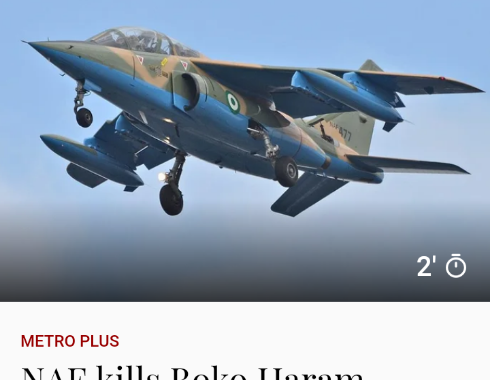War and propaganda: what is the truth about the war against Boko Haram?
The Nigerian Air Force (NAF) on Saturday said it killed scores of Islamic State West African Province(ISWAP) fighters in Dusula, Sambisa Forest, Borno State.
In a press statement, the NAF Director of Public Relations and Information, Air Commodore Ibikunle Daramola, said;
“A series of Intelligence Surveillance and Reconnaissance missions led to “the identification of the command centre with its solar panels, communications equipment and other facilities”.
He said, “In a renewed offensive aimed at further eliminating the remnants of the Boko Haram and ISWAP terrorists in the North-East, the Air Task Force destroyed a Boko Haram command and control centre at Dusula in Sambisa Forest.
“The operation was executed after a series of ISR missions led to the identification of the centre with its solar panels, communications equipment and other facilities.
“The three Alpha jets dispatched by the ATF engaged the location in multiple passes, recording accurate hits on the target area. The structures housing the command centre were destroyed by the strikes while several of the terrorists were neutralised.
“The few surviving terrorists, who were seen attempting to flee the area, were taken out by follow-on attacks. The NAF, operating in concert with surface forces, will sustain its operations against the terrorists in the North-East.”
We chose to publish the NAF statement in full in order to better analyze it. Yes, it is true that there can be no war without propaganda and in the war against Boko Haram, the insurgents have been winning the propaganda war by a wide margin.
In war, there is a strategic value to information. Whoever controls the information nearly always controls the outcome of war. Nigeria has neglected the information sector of the war far too long. To control the morale of troops and the political support for war, you need to have a robust information control and management division. Nigeria has always lacked this.
The problem with the focus on information management during war is that those in charge can afford to totally mislead the people. So, it is always necessary to check against information manipulation by those in charge of war.
The above statement from NAF is a good effort to fill a yawning gap. Nigeria armed forces must start telling us about the war. But the statements coming from them must be carefully and professionally done so they will not be easily seen to be false or exaggerated like the above statement.
In a properly presented statement of this nature, there will be indication as to the airbases or airfields from which the flights were launched. Usually, airbases are heavily defended. So, there is no fear that disclosing such information would endanger the planes or personnel.
What made the statement obviously a propaganda is the emphasis that the mission was for “eliminating the remnants of the Boko Haram and ISWAP terrorists in the North-East”. It is an attempt to suggest that the bulk of the terrorists have been destroyed and that we are dealing with only remnants.
But you only attacked one particular target area. Unless you know the other locations where the enemy is, it is hard to tell the overall impact of these air strikes. The intelligence, surveillance and reconnaissance (ISR) process used is flawed or totally nonexistent. What houses are being struck again two weeks after similar houses were said to have been similarly destroyed. Who else lives in that forest? A simple google map survey will show all the houses in Sambisa. The NAF ought to have a much better surveillance system than what was described here.
The coordination between air and land power is totally absent in the report. You make such airstrikes to prevent the enemy from launching against a particular land target or to soften a target for your advancing land forces. So, normally this sort of statement ought to show such coordination. But it is absent in the report. What target were the enemy fighters advancing against when they were attacked? Did our forces then take the position the enemy was forced to abandon in retreat or are the enemies free to return to occupy that position? This is a territorial war for us. So, what territorial gains are expected yo follow this successful air strikes?
From more indications, it seems that the NAF is way too behind.

